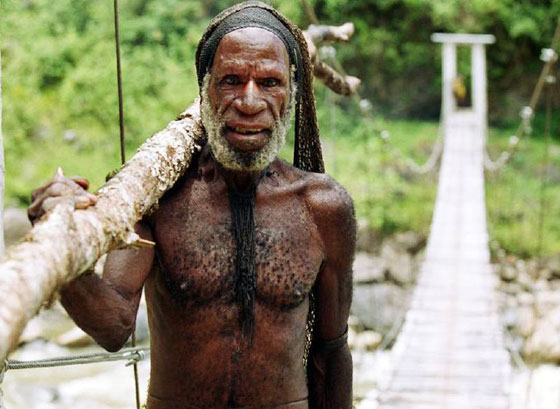The Dani tribe of Papua New Guinea live mostly in the area of the Baliem Valley, which is located in the central highlands (Papua New Guinea). They are more popular with the outside world than other tribes in the area mostly because of tourism.

Contact with the Dani tribe was made in the beginning of the 20th century. There were multiple expeditions; one important one was called the Central New Guinea expedition, where in October 1920, Dutch explorers stayed with the Dani in the area now known as Toli Valley. Another important discovery happened in 1938 by air – Richard Archbold discovered the Dani of the Grand Valley by airplane during his third expedition in April/May that year.
The Dani tribe have some interesting customs. One of which involves funeral ceremonies. When a family member dies, all related females voluntarily cut off part of a finger as a way of showing their grief. This was done using a special cutting tool, after which the severed portion of the finger was burned to ashes, which were then stored in a special place.

Two other main tribes in the fertile Baliem Valley include the Lani (they live in the west) and the Yali (south east). The male members of all three tribes wear a Koteka, which is a penis gourd (a sheath to cover genitals made from dried out gourd). The Dani men use Kotekas that are thin and elongaged (the Lani kotekas are wider while the Yali’s are the longest).
The Dani tribe practice warfare rituals which involve both mock battles and real ones. They also practiced cannibalism. In 1963, Tom Bozeman, a missionary, visited the tribe and described what he saw:
The Danis were always involved in battles and men were being wounded and killed so often, it had become a part of our lives. I remember the Sunday afternoon, though, when some of the villagers living near us dropped by our station after a big battle. I asked them how the battle had gone. They replied, ‘Great! We killed a fellow, speared him right through the heart. He dropped dead and the enemy left him where he fell as they retreated. So we grabbed his body and hid it. Tomorrow we’re going to have a big feast. We want you to come and see it.’

Anthropologist Robert Gardner made a film about the Dani tribe of Papua New Guinea in 1964 called Dead Birds. The documentary was produced as part of the Harvard-Peabody Expedition. The Dani have a legend about a race between a bird and a snake:
[The race] was to determine the lives of human beings. Should men shed their skins and live forever like snakes, or die like birds? The bird won the race, dictating that man must die.
Photo of Dani Tribe (may not be worksafe)
Video Links
Warning: Some parts of these videos may not be work safe.
Dani Tribe 1
Dani Tribe 2
More Info
Some research for this post was taken from the following informative sites:
Ripley’s Believe it Or Not!
Papua Trekking
The Passion






